Definition of TCP/IP in Network Encyclopedia. The most widely used communication protocol.
What is TCP/IP?
TCP/IP is an abbreviation for Transmission Control Protocol/Internet Protocol, an industry-standard protocol suite for wide area networks (WANs) developed in the 1970s and 1980s by the U.S. Department of Defense (DoD). TCP/IP is a routable protocol that is suitable for connecting dissimilar systems (such as Microsoft Windows and UNIX) in heterogeneous networks, and it is the protocol of the worldwide network known as the Internet. Microsoft’s implementation of TCP/IP supports industry standards, and TCP/IP is implemented for all Windows operating systems.

How TCP/IP Works
The architecture of the TCP/IP protocol suite has four layers that map loosely to the seven-layer Open Systems Interconnection (OSI) reference model (as shown in the diagram).
The TCP/IP model is sometimes called the DoD model because TCP/IP was developed in connection with the ARPANET project of the U.S. Department of Defense. Each layer of the TCP/IP protocol suite has its associated component protocols, the most important of which are listed here:
- Application layer protocols: Responsible for application-level access to TCP/IP networking services. These include Dynamic Host Configuration Protocol (DHCP), Domain Name System (DNS), Hypertext Transfer Protocol (HTTP), File Transfer Protocol (FTP), Telnet, Simple Mail Transfer Protocol (SMTP), and Simple Network Management Protocol (SNMP). In the Microsoft implementation of TCP/IP, application layer protocols interact with transport layer protocols by using either Windows Sockets or NetBIOS over TCP/IP (NetBT).
- Transport layer protocols: Establish communication through connection-oriented sessions and connectionless broadcasts. Protocols at this layer include Transmission Control Protocol (TCP) and User Datagram Protocol (UDP).
- Internet layer protocols: Responsible for routing and encapsulation into IP packets. Protocols at this layer include Internet Protocol (IP), Address Resolution Protocol (ARP), Internet Control Message Protocol (ICMP), and Internet Group Management Protocol (IGMP).
- Network layer protocols: Place frames on the network. These protocols include the various local area network (LAN) architectures (such as Ethernet and Token Ring) and WAN telecommunication service technologies – such as Plain Old Telephone Service (POTS), Integrated Services Digital Network (ISDN), and Asynchronous Transfer Mode (ATM).
TCP/IP uses two naming schemes to identify hosts and networks on an internetwork:
- IP addresses: Logical 32-bit (4-byte) numeric addresses of the form w.x.y.z. They are partitioned (using a subnet mask) into two segments, a network ID and a host ID. For example, the IP address 205.116.8.44 is partitioned using the subnet mask 255.255.255.0 into the network ID 25.116.8.0 and the host ID 44. IP addresses are the basic or primary way of identifying hosts and networks on an internetwork; they can be assigned to computers manually or by using DHCP.
- Fully qualified domain names (FQDNs): Alphanumeric names of the form host_name.domain_name in which domain_name is part of DNS, a hierarchical worldwide naming system. For example, the FQDN server12.microsoft.com represents a host named server12 that belongs to a network whose domain name is Microsoft, which belongs to the top-level domain named .com, which belongs to the root DNS domain named dot. FQDNs are friendly names. They are easier to remember than IP addresses and are resolved into IP addresses by using a DNS server or a local hosts file.
History of TCP/IP
Before TCP/IP was the go-to protocol for internet connections we used to use another protocol called the Network Control Protocol (NCP). The NCP was the main protocol for the ARPAnet. The ARPAnet was the precursor to the modern-day internet and originates from 1969. The NCP laster for a few years but it was struggling to keep up with the demands of users. It wasn’t until 1974 that a paper emerged outlining the concept of “A Protocol for Packet Network Interconnection”. This paper, written by Vint Cerf and Bob Kahn outlined the idea of TCP.
It would take until 1978 before TCP/IP came to fruition and until 1983 to completely replace NCP. Seven years later ARPAnet ground to a halt. Yet TCP/IP persisted, undergoing tweaks to keep up with the demands of the future.
Disadvantages of TCP
One of the main disadvantages of TCP/IP is that it isn’t built for LANs. Most administrators use TCP/IP on a LAN but it was originally designed for WAN connections. As such, using TCP/IP within a LAN can lead to inefficiency and bottlenecks. This is particularly true of small networks with limited bandwidth availability.
Security is another issue. TCP/IP is particularly vulnerable to SYN attacks. A SYN attack can be used to interrupt TCP/IP’s three-way handshake by sending connection requests constantly. This makes the computer unable to sustain other connections.
TCP/IP evolution
TCP/IP is a constantly evolving protocol suite whose development is steered by such bodies as the Internet Society (ISOC), the Internet Architecture Board (IAB), and the Internet Engineering Task Force (IETF). The current version of TCP/IP is called IPv4 (Internet Protocol version 4); a new version called IPv6 is already in use.
To learn more about TCP/IP get The Illustrated Network, Second Edition: How TCP/IP Works in a Modern Network from Amazon.
TCP/IP explained (like you were a 10 years old child! really???)
Learn more:
- The Design Philosophy of the DARPA Internet Protocols
- A Protocol for Packet Network Intercommunication, Vinton G. Cerf and Tobert E. Kahn
- Network Fundamentals, Mark Dye, Rick McDonald, Antoon Rufi
- Rethinking the design of the Internet: The end to end arguments vs. the brave new world, Marjory S. Blumenthal and David D. Clark